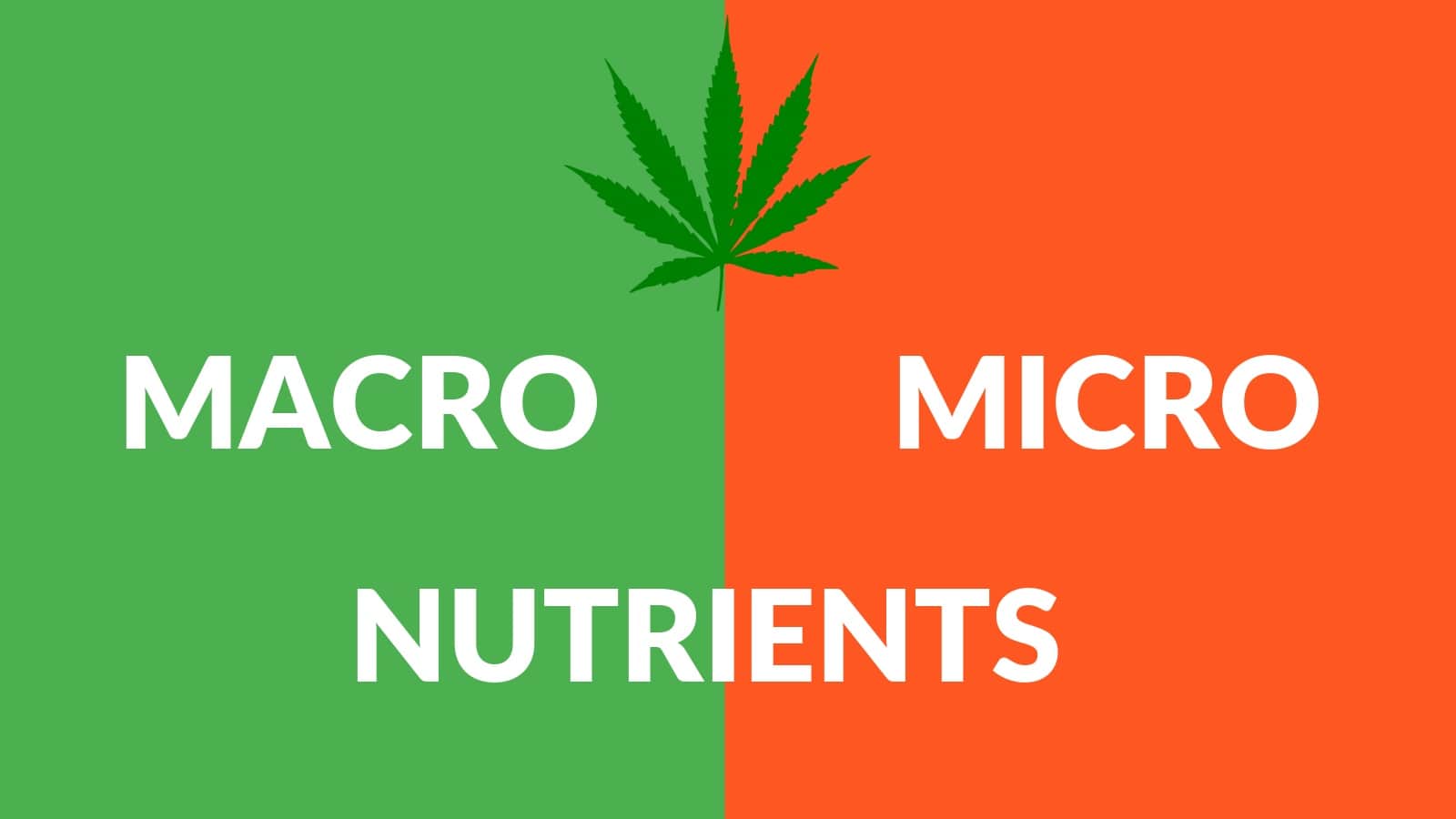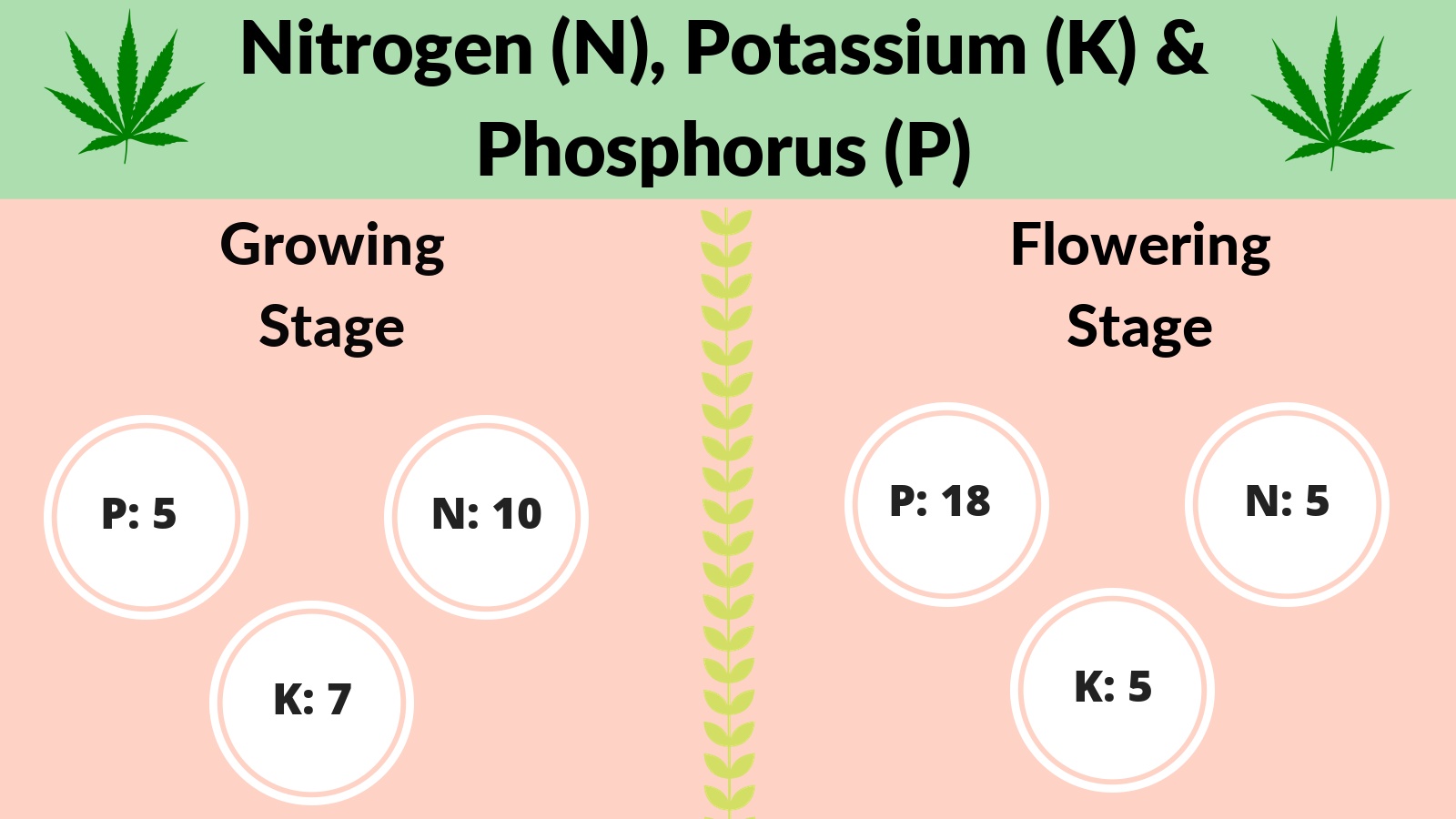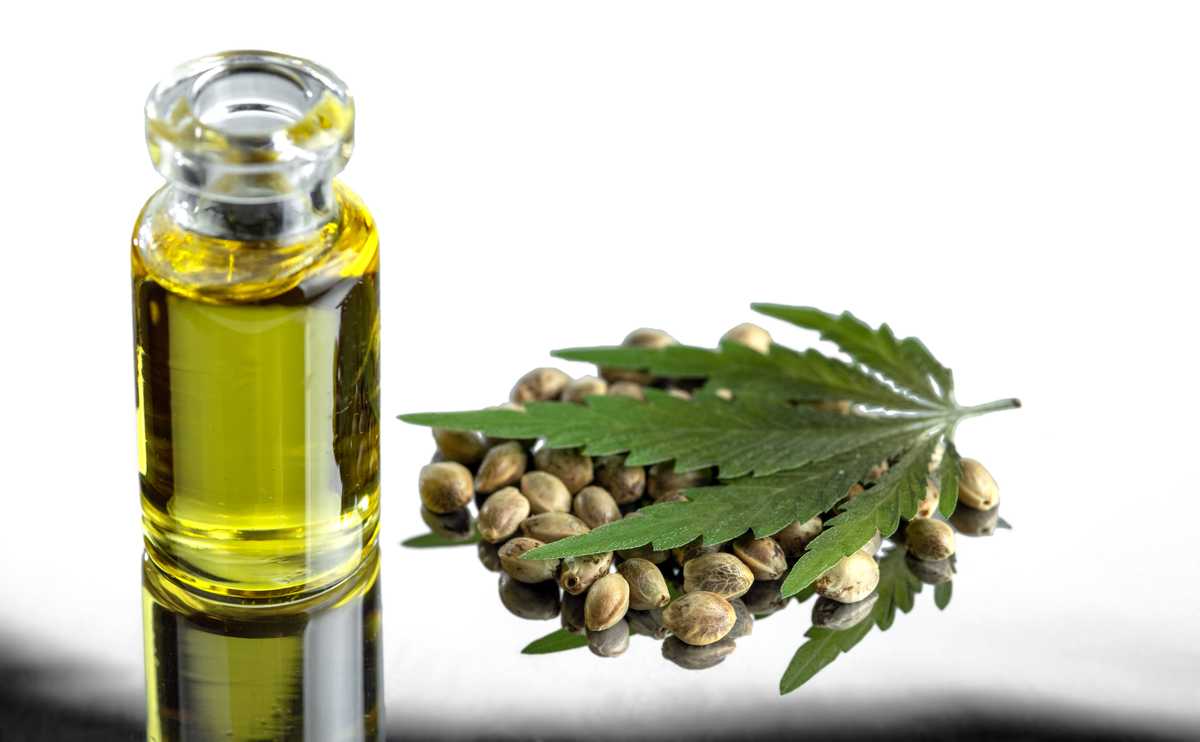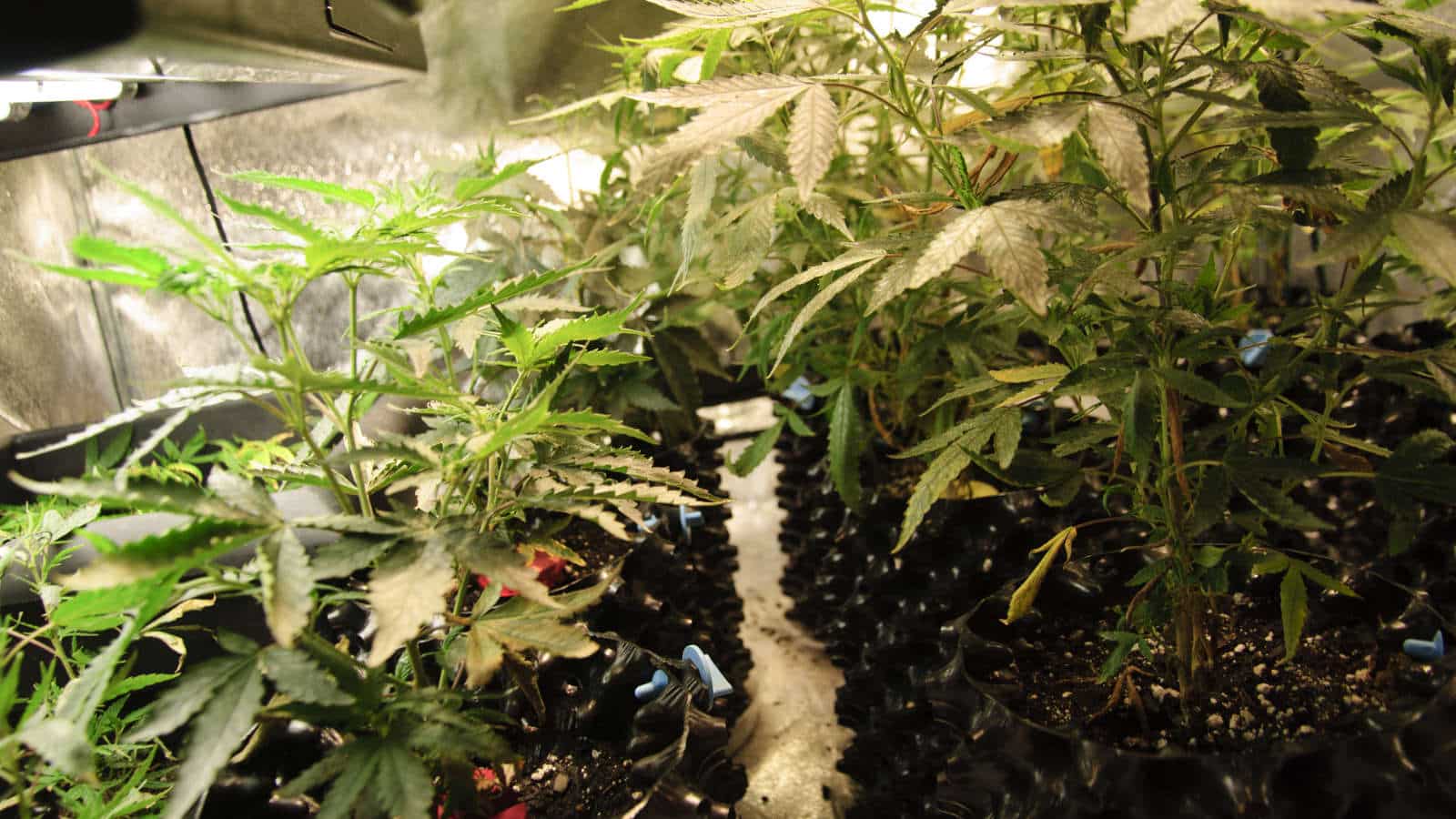
Cannabis Cultivation Macro VS Micro Nutrients
Just like humans, your cannabis plants require a complex diet to thrive and grow. The two main types of nutrients that affect your plants’ growth includes:
- macronutrients: similar to carbs, fats and proteins that make up the human diet
- micronutrients: similar to vitamins and minerals in the human diet that helps us function
Cannabis Plants need a considerable amount of these macronutrients found in soil:
This variation of nutrients is referred to as NKP or NPK. The required amounts of NPK vary depending on the growing stage of the plant.
Growing cannabis plants require more nitrogen (N) and less phosphorus (P) and potassium (K) to reach their full potential.
When flowering, the NPK requirements change. Flowering cannabis plants require little nitrogen (N) and more phosphorus (P) and potassium (K).

Nitrogen, phosphorus and potassium make up the critical macronutrients in the soil that cannabis plants use to grow and flower. On top of these three macronutrients in the soil, there are macronutrients in the air and from water that include: hydrogen, oxygen and carbon.
These are the most notable nutrients for your cannabis plants, but there is an extensive list of micronutrients that your plants require to grow effectively, stay healthy and resist any diseases.
Cannabis plants don’t require vast quantities of micronutrients, but if your plant is missing them, then you can have serious growing problems or low yields.
Macronutrients In Cannabis: Air and Water
Your cannabis plants require three essential macronutrients to grow to its fullest potential. Even though you don’t visibly see it, your cannabis plants are taking in macronutrients from the air and water.
Macronutrients: Carbon
Cannabis plants have tiny pores on the surface of its leaves known as Stomata. These small pores absorb carbon dioxide from the air. Similar to breathing, cannabis stomata pores use small cells that open and close to absorbing carbon dioxide. Plants convert carbon into energy used to grow effectively.
Macronutrients: Hydrogen
Hydrogen is created from water during cannabis plants’ photosynthesis. Photosynthesis is the process plants go through to absorb and utilise the power of the sun (light energy). Hydrogen promotes growth in cannabis plants and drives electron transport during the photosynthesis.
Macronutrients: Oxygen
The cannabis plants’ roots breathe in oxygen. Oxygen is used in the respiration process to help plants release stored energy that was created from its photosynthesis process.
Macronutrients In Cannabis: Soil
The most important macronutrients to cannabis plants that we can control are all in the soil. If you have good soil, then it brings out the full potential of your cannabis plant.
Macronutrients: Nitrogen
Nitrogen is a mobile nutrient found in the form of nitrate. Out of all other macronutrients, nitrogen is the most important for your cannabis plant’s growth.
While nitrogen is abundantly available and easy to add to the soil, cannabis plants require microbes to absorb this macronutrient effectively.
Cannabis plants make heavy use of nitrogen during the growing phase but reduce its consumption during the flowering process.
Macronutrients: Phosphorus
Phosphorus is essential to cannabis plant’s photosynthesis, energy transfer, and the conversion of sugar and starch. It acts as a mobile macronutrient that is found in every cell in your cannabis plant.
It acts as a delivery driver that transports critical nutrients to around the plant. It is responsible for your cannabis root and stem development and plays an essential role in the genetic characteristics of your plant.
When your cannabis plant matures, it helps in the formation of flowers, the overall yield, and its health by resisting diseases.
Macronutrients: Potassium
Potassium is responsible for your cannabis plant’s root development and structure, metabolism, stress resistance and recovery, and overall plant growth.
The pores (stomata) on the plant’s leaves use potassium to open and close itself to carbon dioxide, similar to how we breathe. Every time your cannabis plant “inhales” to absorb carbon dioxide, it loses water, and the potassium macronutrients help close those pores to retain as much water as possible.
Micronutrients In Cannabis
Micronutrients are not consumed as much as macronutrients, but they act like vitamins for your cannabis plant. If you lack vitamin C or vitamin D, then you will have a problem. The same goes for micronutrient deficiencies found in your cannabis plant.
Micronutrients: Boron
Boron plays a critical part in strengthening your cannabis plant’s cell walls. If cannabis has a boron deficiency, then its cells may be compromised, and the plant may become weak and frail. Fixing a boron deficiency will allow your plant to cross-link carbohydrate molecules to strengthen cell walls.
Micronutrients: Calcium
Just like humans with bone strength, plants use calcium to strengthen its structure. The calcium holds membranes and cells together. The calcium micronutrient also regulates hormone and enzyme activity within cannabis plants. A calcium deficiency in cannabis may negatively affect its structure, the hormones and enzyme regulation that could lead to low stunted growth and poor flowering yields.
Micronutrients: Iron
Iron is just as crucial to cannabis plants as it is to humans. The iron micronutrient contributes to the production of sugar from light energy and is a part of critical enzymes and pigments in your plant. An iron deficiency, otherwise known as lime-induced chlorosis, will turn your cannabis leaves yellow and could lead to your plants’ death. It is typically easy to spot iron deficiencies in cannabis as your bright green marijuana leaf turns yellow.
Micronutrients: Copper
The copper micronutrient is a simple mobile nutrient that moves around the plant to promote effective photosynthesis in your cannabis plant. A copper deficiency in cannabis plants leads to low growth and yields during the flowering process due to a lack of energy and low metabolism.
Micronutrients: Magnesium
Out of all the micronutrients that contribute to your cannabis plant’s photosynthesis process, magnesium plays the most significant part. Magnesium is a micronutrient that helps cannabis plants absorb sunlight that is used to create sugars. Cannabis plants with a magnesium deficiency can be visually seen with their leaves aging with a distinct yellow colour, and can soon lead to death as your plant will starve without sugars and photosynthesis.
Micronutrients: Manganese
Manganese is a micronutrient that assists in cannabis plant’s absorption of nitrogen. It also contributes to your plant’s ability to reproduce, pollen growth and germination. Manganese is the most vital micronutrient to encourage the breeding of new cannabis strains.
Micronutrients: Molybdenum
Molybdenum is a micronutrient that plays a critical but straightforward role in cannabis plants’ ability to synthesise amino acids. The enzymes in cannabis plants that are affected by Molybdenum help cover nitrate to nitrite, and to also convert nitrite to ammonia. A cannabis plant suffering from molybdenum deficiency is visually seen with yellow and pale leaves. A lack of molybdenum is potentially fatal to your cannabis plants growth.
Micronutrients: Sulphur
Sulphur is a simple micronutrient in cannabis plants that support the production of enzymes that are critical in the growth and the plant’s overall lifecycle. A sulphur deficiency in your cannabis plants shows as a pale-green or pale-yellow coloured leaves.
Micronutrients: Zinc
Zinc is a micronutrient that assists in the creation of various proteins and enzymes critical to cannabis plants growth. A zinc deficiency in cannabis plants affects hormone production and can cause frail, weakness and stunted growth.
Conclusion: Macronutrients VS Micronutrients
Both macronutrients and micronutrients are essential in the growing phase and flowering phase of your cannabis plant.
The levels of NPK macronutrients change after the cannabis plant transitions from its growth stage to the flowering stage.
Your cannabis plant absorbs macronutrients from the air and soil, but we focus on the soil as the most common deficiency, and health problems in cannabis plants are due to a lack of macronutrients in the soil.
The micronutrients are required in a much smaller quantity, but each performs a vital role in the function, photosynthesis, and reproduction of your cannabis plant.
Keep an eye out for macro and micronutrient deficiencies as these can ruin your cannabis crops.

James King
James is an experienced writer and legal cannabis advocate in Australia. He answers all the questions about business, legalisation and medicinal cannabis.
Disclaimer: Cannabis Place are not doctors and we recommend consulting health professionals for accurate information. This site may contain information regarding drugs. This medicinal cannabis content is designed for an 18+ audience. Click here for our full disclaimer



